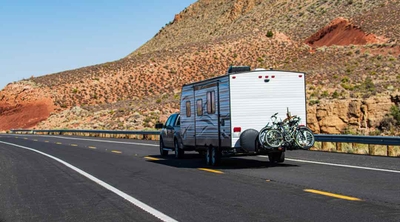What is an off-road RV?
4 min read
Taking your RV or camper off-road is a great way to see some of the country’s most beautiful areas. It’s a great way to unwind and experience quiet and solitude that can be hard to find in even the most remote campgrounds. And while many of the best RVs for boondocking are 4WD off-road motorhomes, you don’t necessarily have to buy an off-road camper to enjoy the benefits of camping off the grid. Here’s an overview of the different types of off-road RVs and campers.
What are the different types of off-road RVs and campers?
If you’re buying an RV to take off-road, four-wheel drive can make it easier but limit your choices. Most 4WD off-road motorhome category options are Class B motorhomes, the smallest type of motorhome. That’s because Class Bs are built on a converted truck or van chassis, making them a natural fit for rugged terrain. Options for 4WD off-road motorhomes include:
Truck campers
Some great extreme off-road campers are simply pop-ups built to attach to a normal pickup truck. When packed up, these types aren’t much bigger than the truck. You can detach the camper pop-up to use the truck as a daily driver when you’re not camping. The ability to detach the camper gives you the maximum flexibility in choosing the truck and driving experience you want. Any compatible 4WD truck can become an off-road RV camper.
Class B motorhomes
Unlike truck campers, Class B motorhomes aren’t detachable from the truck or van body they’re built on — they’re permanent RVs. However, because they’re built on a normal passenger vehicle body, they’re some of the smallest and most maneuverable RVs available. Depending on the van or truck used for the conversion, you can find them in both 2WD and 4WD off-road motorhome configurations.
Class A and Class C off-road motorhomes
As RVs increase in size, it can be more difficult to make them suited to the demands of off-road travel. Some companies make larger models intended for off-road use. Manufacturers have designed some of these large off-road RV motorhomes to carry a vehicle inside or behind them. Once you get to your campsite, you can run day trips with a small truck or SUV instead of driving the entire motorhome. Because of their size, they may even feature six-wheel drive (rather than 4WD).
Off-road trailers
Driving a single vehicle made for off-road use is the simplest way to go off-road in your RV or camper, but it’s not the only way. What if you already have a good towing vehicle suited for off-road driving? You might consider a camper trailer intended specifically for off-road camping. These trailers tend to have better shock absorption and higher clearances, as well as sturdier builds to handle the rigors of off-road travel.
Learn more about the different types of RVs and the difference between RVs vs. trailers.
Other considerations for off-road RVing
If you buy an RV for off-roading with two-wheel drive, you’ll still be able to get out onto those dreamy off-road campsites, but you’ll need to prepare yourself. Be realistic about your RV’s limits and how capable it is. Learning how to maneuver your home-on-wheels off-road will take some practice. A good place to start is with basic off-roading tips and accessories that will help you traverse rougher terrain than you’re used to.
Always scout ahead
This is one of the most important tips to practice while off-roading in your RV. If you drive down a new road, take time to walk or bike it before you drive it. If you’re towing a smaller vehicle behind your RV, this is a good time to unhook it and use it to assess how bad or good the road is. Unhooking your day vehicle can also make it easier to navigate trails in the RV.
Check the weather
Be sure to check the weather before taking your RV off road. Off-roading in your RV can take you to some stunning destinations, but a hard rain can drastically change your route. An accessible road can quickly become impassable. If rain is in the forecast for days on end, it may be best to skip that five-mile dirt road.
Use Google Maps satellite
If you’re unsure about a road you plan on taking your RV down, try looking on Google Maps with the satellite view to see what you’re getting yourself into. Reviewing the map will give you a small amount of insight into the terrain you’re trying to travel through.
Sometimes, you can use Google Maps satellite view to find beautiful campsites tucked away from other campers. It can’t hurt to take a few extra minutes to get a bird’s-eye view of your path.
Take it slow
If you’re planning on off-roading in your RV, prepare to cross paths with vehicles that are much more capable than any two-wheel-drive RV. You’re in the four-wheel-drive territory after all.
Don’t feel the need to rush down these bumpy roads; just be courteous to other vehicles that can move faster than you. Move on over, wave by that Jeep, and then continue slowly. If you’re traveling with another person, have them hop out of the RV to help you maneuver through some sketchier spots.
Stock up on off-road RV accessories
Driving an RV with all-wheel drive can give you extra stability and power on dirt roads and other terrains off the beaten path, but it isn’t always necessary. The right accessories can help any RV handle the rigors of off-road travel better, whether your rig has two-wheel or four-wheel drive.
Important off-road accessories include all-terrain tires, recovery tracks, tow lines, portable air compressors and more.




